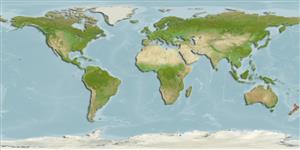>
Blenniiformes (Blennies) >
Tripterygiidae (Triplefin blennies) > Tripterygiinae
Etymology: Ruanoho: A vernacular name in maori, New Zealand.
Environment: milieu / climate zone / depth range / distribution range
Ecologia
marinhas bentopelágico; intervalo de profundidade 0 - 21 m (Ref. 84086). Subtropical
Southwest Pacific: New Zealand.
Tamanho / Peso / Idade
Maturity: Lm ? range ? - ? cm
Max length : 9.0 cm TL macho/indeterminado; (Ref. 84086)
Adults are commonly found in sheltered to moderately exposed areas shallower down to 21 m; less associated with rocky substratum, but may be found under, side or top of rocks. They are found in offshore islands and coastal mainland areas (Ref. 84086). They feed on a range of benthic invertebrates including ophiuroids, archaeogastropods, trichoptera and errant polychaetes (Ref. 84084). Eggs are hemispherical and covered with numerous sticky threads that anchor them in the algae on the nesting sites (Ref. 240). Larvae are planktonic which occur primarily in shallow, nearshore waters (Ref. 94114).
Ciclo de vida ou comportamento de acasalamento
Maturities | Reprodução | Spawnings | Egg(s) | Fecundities | Larvas
Wellenreuther, M., C. Syms and K.D. Clements, 2008. Body size and ecological diversification in a sister species pair of triplefin fishes. Evol. Ecol. 22:575-592. (Ref. 84086)
Status na Lista Vermelha da UICN (Ref. 130435)
Ameaça para os humanos
Harmless
Uso pelos humanos
Ferramentas
Relatórios especiais
Baixar XML
Fontes da internet
Estimates based on models
Preferred temperature (Ref.
123201): 13 - 20.3, mean 16.5 °C (based on 130 cells).
Índice de diversidade filogenética (Ref.
82804): PD
50 = 0.7500 [Uniqueness, from 0.5 = low to 2.0 = high].
Bayesian length-weight: a=0.01000 (0.00244 - 0.04107), b=3.04 (2.81 - 3.27), in cm total length, based on all LWR estimates for this body shape (Ref.
93245).
Nível Trófico (Ref.
69278): 3.3 ±0.4 se; based on size and trophs of closest relatives
Resiliência (Ref.
120179): Elevada, tempo mínimo de duplicação da população menor que 15 meses (Preliminary K or Fecundity.).
Fishing Vulnerability (Ref.
59153): Low vulnerability (10 of 100).
Nutrients (Ref.
124155): Calcium = 270 [134, 635] mg/100g; Iron = 1.7 [0.8, 3.3] mg/100g; Protein = 17.8 [16.7, 19.0] %; Omega3 = 0.238 [0.102, 0.555] g/100g; Selenium = 28.4 [10.1, 75.9] μg/100g; VitaminA = 17.2 [4.1, 73.9] μg/100g; Zinc = 1.83 [1.08, 2.83] mg/100g (wet weight);
